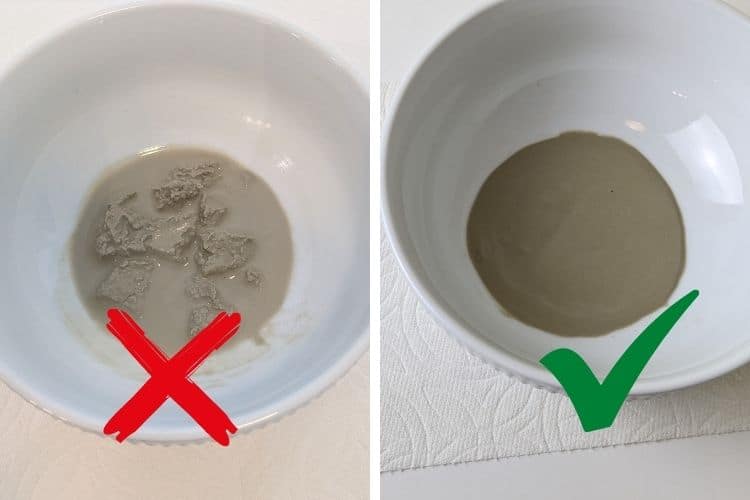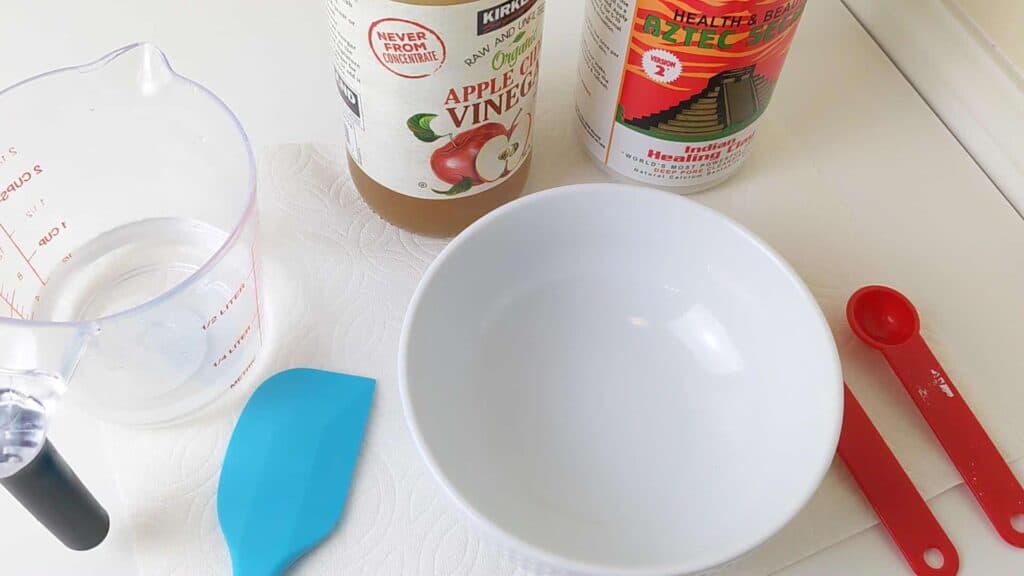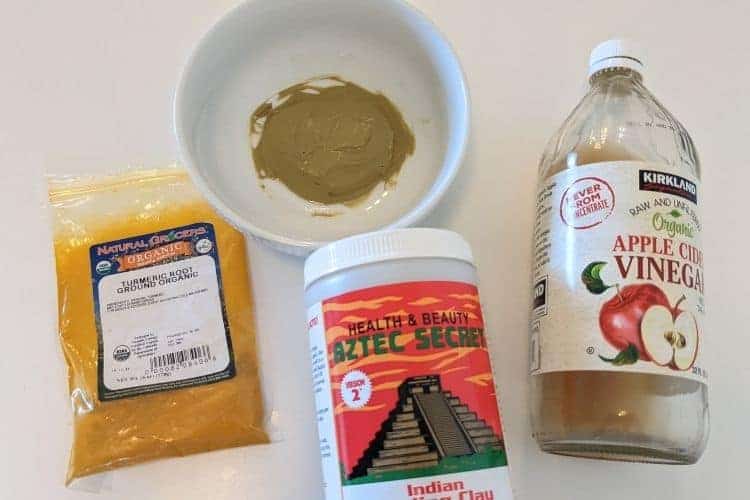
If you’ve ever used bentonite clay (such as the popular Aztec brand) then you know how easy it is to end up with a chunky and lumpy mess. Far different from the smooth masks that are advertised! So then, how do you make a bentonite clay mask smooth?
In general, there are two ways to make a smooth and lump-free bentonite clay mask: mix it with a combination of apple cider vinegar and honey or with apple cider vinegar only. In both cases, it’s also important to add in the clay slowly rather than all at once. This will further help to minimize lumps.
While some people try to skip the apple cider vinegar, it’s necessary for two reasons:
- bentonite clay dissolves much better in ACV than in other liquids (like water).
- adjusts the pH of the mask so that it’s more suitable for skin.
In this article I’m going to walk you through the exact steps that you can follow to make bentonite clay masks without lumps, as well as:
- How to ensure that your mask has a skin-friendly pH.
- Essential oils you can add a bentonite mask.
- How to combine bentonite and turmeric for dark spots.
- Additional tips on storing and using your mask.
NOTE: I live in high altitude and sometimes my DIY results are different from someone at a different altitude. So just keep in mind that the tips I provide here work for my temperamental environment 🙂
HOW TO MAKE A SMOOTH BENTONITE CLAY MASK AT HOME

STEP 1: Add apple cider to a bowl
The first step for a smooth bentonite clay mask is to use apple cider vinegar (as opposed to plain water). Here’s why this matters:
- The pH of bentonite clay is between 9 and 10, which is on the alkaline side of the pH scale (source).
- Apple cider vinegar’s pH is between 2 and 3 which is very acidic.
Now, when it comes to the skin, its pH sits in the range of 4.7 – 5.5, which is moderately acidic. So, overall, mixing bentonite and ACV results in a pH that is closer to what the skin prefers.
NOTE: if you really can’t stand the smell of ACV, you can do a 50/50 mix of ACV and water. But just be aware that the resulting mask will be on the alkaline side and will tend to have more lumps.
STEP 2: Add an equal amount of clay to the apple cider vinegar
This is where the magic happens for your mask. In this step you want to:
- add an equal amount of bentonite clay to the ACV. This means 1 Tsbp ACV to 1Tbsp clay, 2 Tbsp ACV to 2 Tbsp clay and so on.
- sometimes adding the clay slowly, rather than all at once, can produce a smoother mixture. For example, if you’re using 2 Tbsp clay, add in 1 Tbsp. Stir that in, then add in the remaining clay.
- use a silicone spatula to mix the mask. The silicone spatula helps to more easily soften any bits of clay that may try to clump up.
3. Add honey (or allow the mask to settle)
Honey’s smooth texture is fantastic for quickly turning a bentonite clay mask into a smooth and creamy mixture.
All you need is 1/2 to 1 teaspoon of raw honey for every 2 Tbsp of bentonite clay. If you like a thick mask, use 1/2 teaspoon. But if you prefer a thinner consistency for your mask, then do 1 teaspoon of honey.
Now, what if you’re allergic to honey or it simply doesn’t agree with your skin? Well the other option is to:
- let the mask sit on a countertop for 2 – 3 minutes. For some reason, giving the mixture some time to “settle” seems to help it be smoother.
- stir the mixture again.
- now you’ll have a lump-free and creamier mask.
Here’s a quick video of the honey-free method.
BENTONITE CLAY MASK RECIPE FOR DARK SPOTS (WITH TURMERIC)

Turmeric is well known for its ability to help fade dark spots and improve hyperpigmentation. Add this recipe to your skincare routine to help with brightening and evening out your natural skin tone.
As you can see from the above picture, this mask isn’t yellow like most turmeric-based masks. That’s because I didn’t use a lot of turmeric; it’s a potent spice and I have a “less is more” philosophy when using it in DIY recipes.
However, if you’d like to have more turmeric in it, feel free to increase the quantity.
Also, since this mask doesn’t have too much turmeric in it, you don’t have to worry about staining.
Ingredients
2 tbsp ACV
2 tbsp bentonite clay
1/2 tsp turmeric powder
Instructions
1. Combine the ACV and bentonite clay.
2. Add in the turmeric powder and mix until well combined.
3. Apply onto freshly cleaned skin. Allow to dry for about 8 minutes.
4. Rinse off with warm water.
BENTONITE CLAY MASK RECIPE WITH ESSENTIAL OILS
You can boost the therapeutic benefits of your bentonite clay mask by adding in skin-friendly essential oils such as:
- Copaiba.
- Frankincense.
- Clary sage.
- Lavender.
- Tea tree oil.
- Chamomile.
- Geranium.
- Sandalwood.
- Rose.
In my opinion, a combination of tea tree, copaiba, lavender and bentonite is ideal for acne because you benefit from tea tree’s anti-acne properties, as well as copaiba and lavender’s soothing, anti-inflammatory properties.
Here’s a quick recipe.
Ingredients
2 tbsp apple cider vinegar
2 tbsp bentonite clay
1 drop copaiba oil
1 drop tea tree oil
1 drop lavender oil
Instructions
1. Mix the ACV and bentonite clay until well combined and smooth.
2. Add the essential oil drops and stir to mix in.
3. Apply to freshly washed face and allow to sit for about 8 minutes (it should start to dry at this point but not be completely hardened).
4. Rinse off with water.
5. Follow with a soothing moisturizer or serum.
RELATED QUESTIONS ABOUT PREPARING A BENTONITE CLAY MASK WITHOUT CHUNKS
What happens if you leave Aztec clay mask on too long?
The longer bentonite clay stays on the face, the more it soaks up moisture and sebum. This dries up the skin too much, which could cause redness and other signs of dehydration or irritation.
Can you save a bentonite clay mask?
The only way to preserve a bentonite clay mask is to add in a cosmetic preservative. Without a preservative, the mask can eventually develop mold. In addition, the longer an unpreserved clay mask sits around, the more it loses moisture and dries up.
Should clay masks be refrigerated?
You can refrigerate a homemade clay mask for about a day. However, the longer it sits in the fridge, the more it’s likely to develop mold.
CONCLUSION
Apple cider vinegar and honey is all you need to make a lump-free bentonite clay mask. The honey provides smoothness while the ACV balances out bentonite’s alkaline pH.
I hope you have fun making these recipes!
You Might Also Enjoy:
What To Do Before and After Using A Clay Mask On Face: Step by Step Guide
What to Mix with Bentonite Clay For A Face Mask: 13 Skin-Loving Ingredients
Honey Mask vs Clay Mask: Benefits, How To Use and Recipes
Kaolin Clay Mask for Dry Skin: Benefits and Tips For A Healthy Glow
5 Things To Know Before Using Clay for Dry Skin (+ Bonus Recipe)

